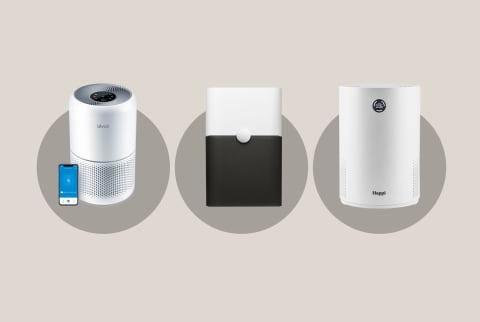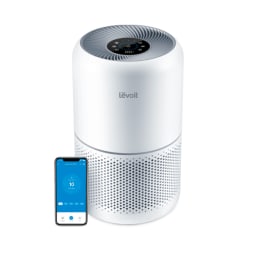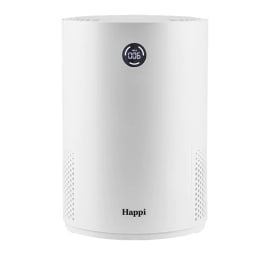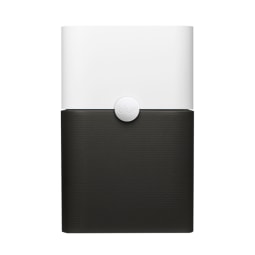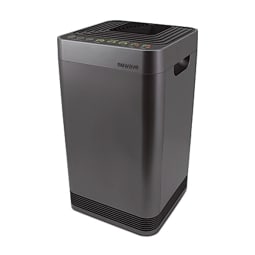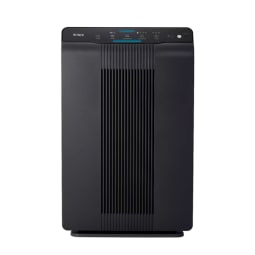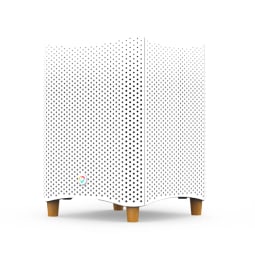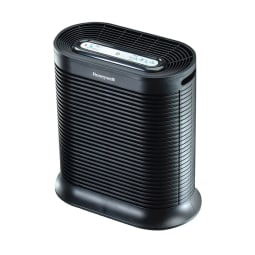After all, research shows that dust and other indoor air pollutants can be harmful to our respiratory health1. It can also exacerbate symptoms of sneezing and wheezing, as well as conditions like asthma. Adding an air purifier for dust to your space is a great way to eliminate this pesky health concern—and we’ve already spoken with experts to help you find the best device to bust some dust. Purifiers use a range of filter materials, including HEPA (high-efficiency particulate air), activated carbon, media, spun glass, and pleated filters. “Some machines also use a combination of these materials to cleanse the air further,” Rubino adds. When it comes to filters, Rubino and allergist Anjuli Mehrotra, M.D., agree that HEPA is the gold standard, especially as it’s the only filter certified to meet the U.S. Department of Energy’s standards2. “For allergies, we recommend HEPA filters, as they are able to filter out allergens that are less than 10 microns in size, which include airborne dust particles; pollen from trees, grasses, and weeds; as well as pet dander and mold spores,” Mehrotra advises. “Not all allergens are airborne, and air filters may not work as well for these. Dust mites (microscopic insects that live in dust and are responsible for most dust allergies) or other allergens that have settled into the ground, carpet, or furnishings,” explains Mehrotra. In other words, a purifier isn’t a replacement for a vacuum. Your best bet for truly combating dust (and dust mites) is combining an air purifier with an effective cleaning routine—and paying close attention to your rugs, carpet, and furniture. Filter quality Rubino and Mehrotra both note that the quality of a purifier depends on the quality of the filter. “A solid air purifier should at least meet HEPA status, meaning that it removes 99.97% of particles as small as 0.3 micron,” says Rubino. For reference, a micron is a unit of measurement equal to one-millionth of a meter. Here’s how the most common particle pollutants stack up: Cost of filter replacements Because purifiers require a filter change every three to 12 months (the time frame varies by brand and how often you run your device), you’ll want to consider the cost of new filters on top of the machine’s cost. Each brand has its own type of HEPA filter, and they all come at different prices—some brands even offer a subscription discount for scheduled refills. Room size “It’s important to consider the size of the room when choosing a purifier,” says Mehrotra. “The filtration process can vary from product to product, but the goal of air purification is about five or six air changes per hour in the room, a rate that is sufficient to decrease particle levels in the room by about 70%.” One way to gauge the effectiveness of a purifier is the product’s CADR, or Clean Air Delivery Rate—a measurement developed by the Association of Home Appliance Manufacturers (AHAM) in the 1980s. “CADR measures the amount of particle-free air being delivered into the room,” explains Mehrotra. “It reflects both how effective the filter is and the amount of air going through the filter. The higher the clean air delivery rate, the larger the size room that can be properly cleaned.” Mehrotra adds that a good CADR rating is equal to at least two-thirds of the room’s area in square feet. For example, a room that measures 10 feet by 15 feet has an area of 150 square feet. For this room, a good CADR rating would be at least 100 cubic feet per minute (cfm). What customers say: What customers say: There aren’t a ton of reviews of this purifier, but most of the reviews that do exist are positive. One reviewer writes, “My Happi works to make certain that lingering odors or dust are always under control! This air cleaner really and truly is very quiet, which in my book makes it a winner! I think this is a perfect choice for smaller rooms; utility, laundry, extra bedroom or office.” On the con side, some people say the “change filter” notification goes off earlier than six months and makes an annoying beep sound. What customers say: This filter gets great reviews from customers—82% of the 11,000 ratings give it five out of five stars. “I was having great difficulty breathing after a then-unknown mold exposure. Between the time the mold was discovered and the time it took to get a contractor out to take care of it, I could not breathe indoors. This purifier allowed me to breathe almost immediately.” Some negative reviews from people say they wish the 211+ had a timer, and some people complain that it’s expensive for the lack of features. What customers say: Coolest of all, this Energy Star–certified pick automatically activates “Sleep Mode” when the room is darkened for a quieter run and changes back to “Auto Mode” when it senses light. In terms of upkeep, Winix recommends washing the pre-filter every two weeks and the carbon filter every three months. You’ll also need to get a new carbon and HEPA filter every 12 months. What customers say: Mila can also act as a carbon monoxide detector and monitors the humidity level in your room to alert you about possible mold growth. What customers say: The pre-filter captures large particles such as dust and pet fur and includes carbon to reduce VOCs & odors from smoke and cooking—the HEPA filter picks up the rest. What customers say: One downside, though, is that Honeywell suggests you replace the pre-filter every three months. Some reviewers also say it’s rather loud compared to other purifiers. Yes. Pre-filters can benefit from a wash or a vacuum every month or so, and you’ll need to replace the HEPA filter (and possibly other filters, depending on the design) to keep your device running smoothly and effectively. How often should you clean an air purifier? Each product is different, and the lifespan of a filter can last anywhere between three and 12 months. To get the most out of your filter, it’s best to adhere to the manufacturer’s suggested filter replacement times. Should I leave my air purifier on all the time? How often you run your air purifier will depend on your home’s air quality and your personal preferences. If you have allergies or live in a city with poor air quality, you may run your purifier more often. Focusing on an energy-efficient model will help keep electric costs low.


